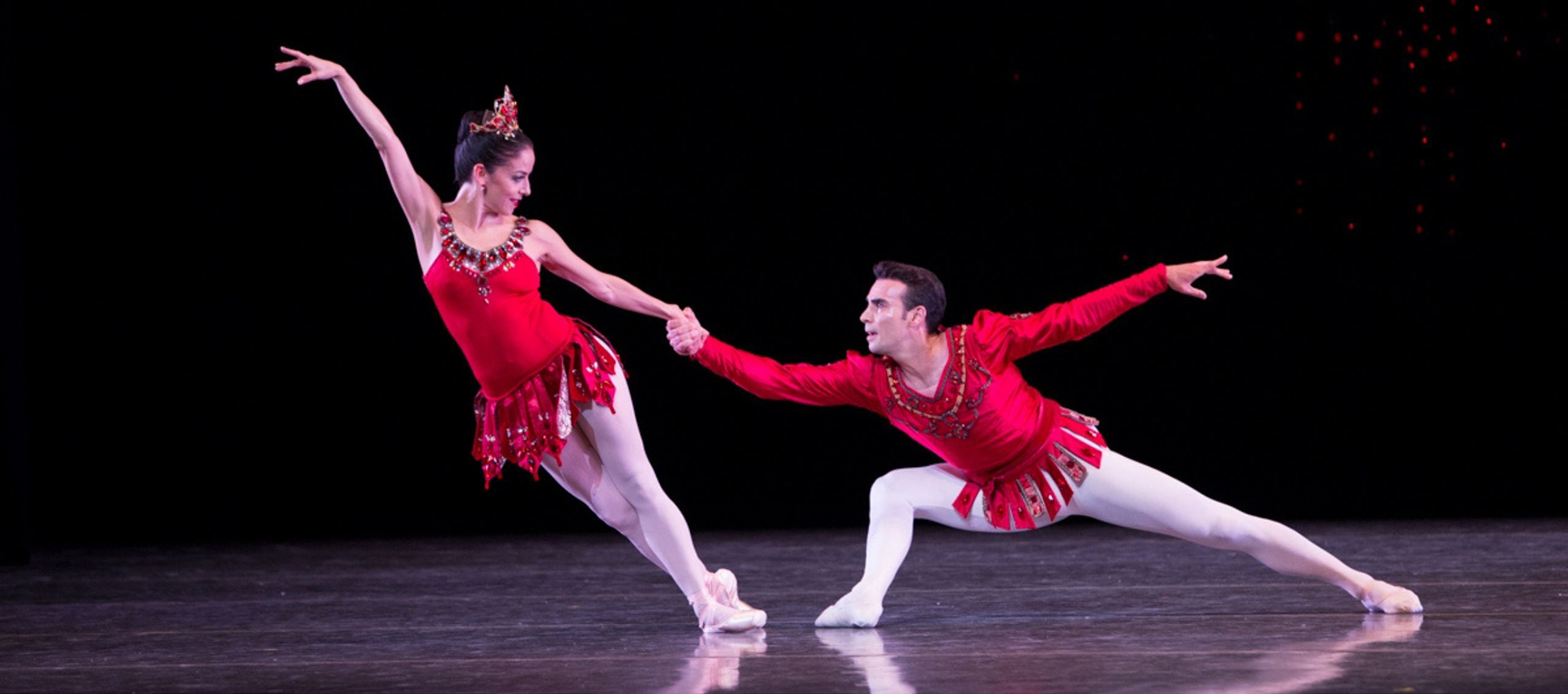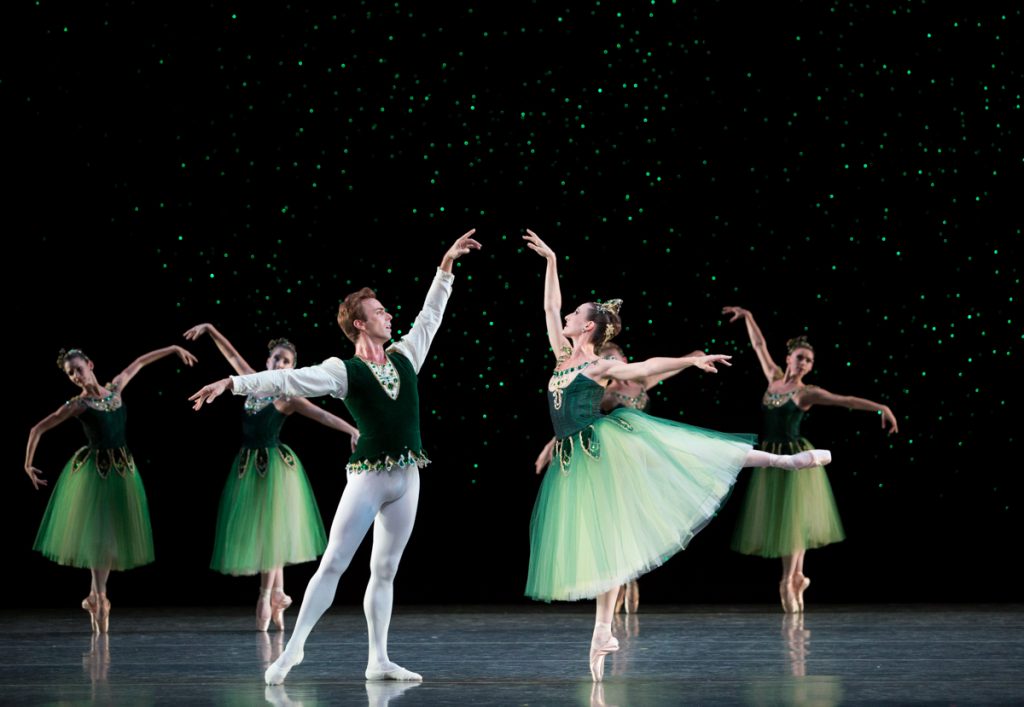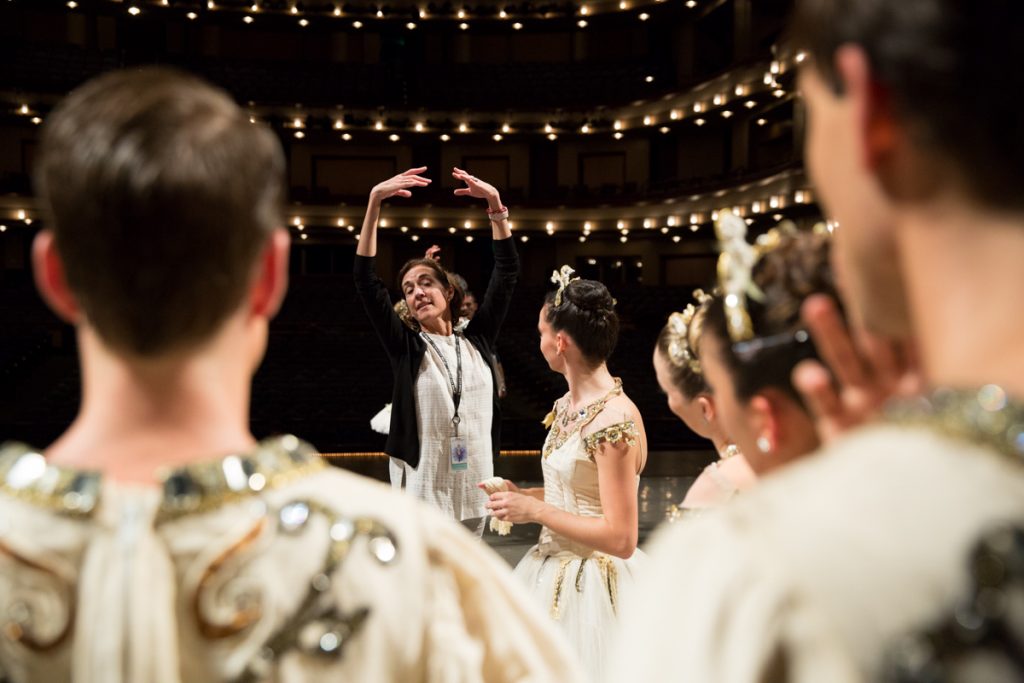
The Dream, The Showstopper and The Beauty
We sat down with three leading ballerinas – Tricia Alberston on Emeralds, Jordan-Elizabeth Long on Rubies, and Katia Carranza on Rubies and Diamonds – to share their take on the genius of Balanchine and what makes Jewels such an endearing, popular ballet.
Like brilliant bursts of light refracting from the world’s most sought-after gemstones, MCB’s performances of George Balanchine’s pure dance triptych, Jewels, have dazzled audiences since the company premiered it in 1992.
A crowning jewel in the Balanchine canon, the ballet was inspired by a visit the choreographer took to famed French jewelers Van Cleef and Arpels. Jewels is composed of three mini-ballets Emeralds, Rubies, and Diamonds. Each piece is composed to music by a different composer, and brilliantly evokes three distinctive styles of ballet: French, American, and Russian.
What makes Emeralds so exceptional in Balanchine’s Jewels?
Tricia: To me, Emeralds is the dream leading into the rest of Jewels. There is something other-worldly about it – a water quality exists with moments of joy, melancholy, and hopeful human connection. I like to envision I’m underwater. The unique port de bras (graceful movements of the arms) in this ballet makes it very special. I imagine I’m pushing the water, dancing through it, letting it help to suspend me. Since the composer is French, I also like to imagine leaving trails of alluring perfume behind me.
Tell us more about the music?
Tricia: The music by French composer Gabriel Fauré is the kind that makes you take a deep breath and appreciate life. It flutters and bends and is full of hope. It takes you on a journey.

What do you enjoy most about performing Rubies?
Jordan-Elizabeth: I love how seamlessly Balanchine has married the choreography to the music. He was famous for saying “see the music, hear the dance,” and Rubies is a perfect example of that. Balanchine was friends with the Rubies composer, Igor Stravinsky, and you can see his understanding of the different roles of the orchestra in the steps he gives the other groups of dancers to do. I have a strong connection to music, and my favorite thing about dancing is that it allows a person to become the music. When I dance the ‘Tall Girl’ role in Rubies, I feel like I am one of the string instruments in the orchestra, making the music with my body.
The audience tends to love Rubies. What makes this piece such a showstopper?
Jordan-Elizabeth: Rubies is a ballet that all dancers want to dance and all audiences love seeing. It is full of fun, joy, and a little bit of spiciness and sass. It is so exciting in its contrast with the preceding ballet, Emeralds. Emeralds has an entirely different mood. I always like to think of it as the appetizer of the whole evening, getting the audience relaxed and ready to be taken away to a different realm. When the curtain goes up on Rubies, the entire audience sits up in their seats a little bit. I think seeing all those people on stage on their toes is always kind of mysterious: “What’s going to happen now?”

Katia Carranza is praised for her portrayals in both Rubies and Diamonds.
Can you tell us what makes these works so different and what you enjoy most about performing them?
Katia: Rubies is one of the most enjoyable ballets to perform. It is also tough because the energy is so high but at the same time, it is so fun that you forget how tiring it is. Everything about Rubies is thrilling. The movements, the hips, the legs kicking, keeping your balance out of center… even the color red. It’s electrifying.
Diamonds is completely different. I love the grand pas de deux. It is so pure and beautiful, just like a diamond. It is very controlled, elegant, and opulent. With Tchaikovsky’s music, I feel like a queen. It is very grand, imperial Russia. It’s majestic.
And finally. What do you think is the genius of Balanchine’s choreography?
Tricia: What isn’t the genius of Balanchine’s choreography?! The patterns of the corps de ballet and how he weaves the principals amongst them is incredible. And the musicality. He always made steps that speak the music which makes his works the most satisfying to watch and to dance.

Experience George Balanchine’s beguiling Jewels performed to live music.
Kravis Center: March 18-20
Arsht Center: April 1-3
Broward Center: April 23-24
Tickets from $30
Photo Credits: Katia Carranza and Renato Penteado in “Rubies” from Jewels. Choreography by George Balanchine © The George Balanchine Trust. Photo © Alexander Iziliaev. Tricia Albertson and Rainer Krenstetter in “Emeralds” from Jewels. Choreography by George Balanchine © The George Balanchine Trust. Photo © Alexander Iziliaev. Jordan-Elizabeth Long in “Rubies” from Jewels. Choreography by George Balanchine © The George Balanchine Trust. Photo © Alexander Iziliaev. MCB Artistic Director Lourdes Lopez teaching “Diamonds” from Jewels. Choreography by George Balanchine © The George Balanchine Trust. Photo © Alexander Iziliaev.
